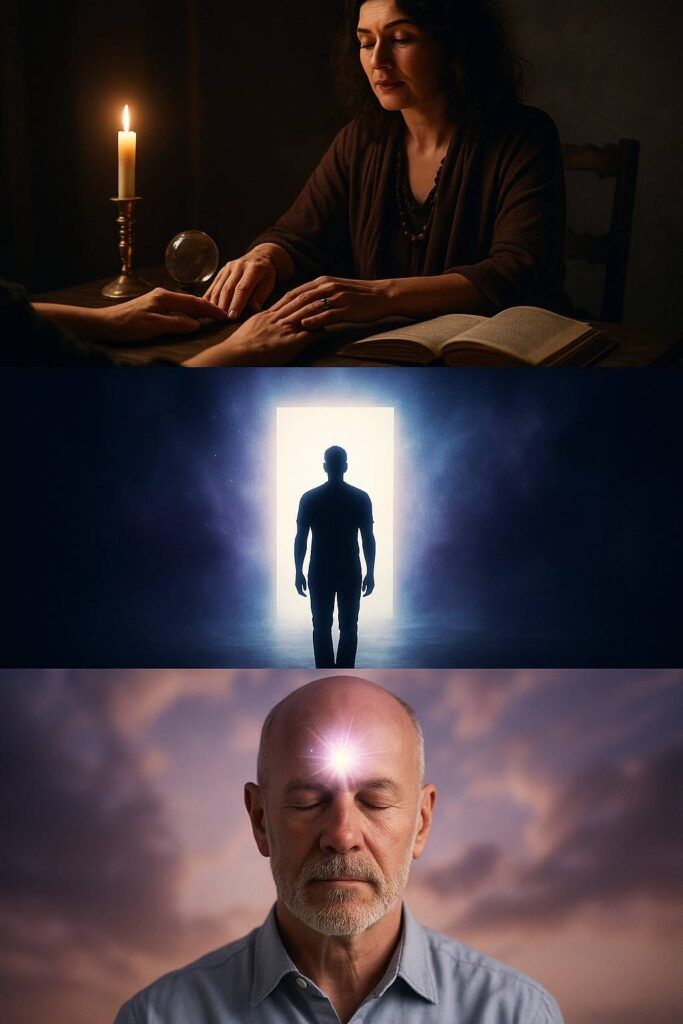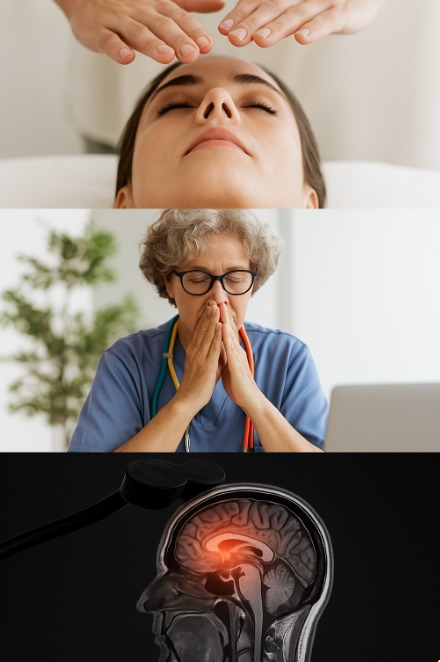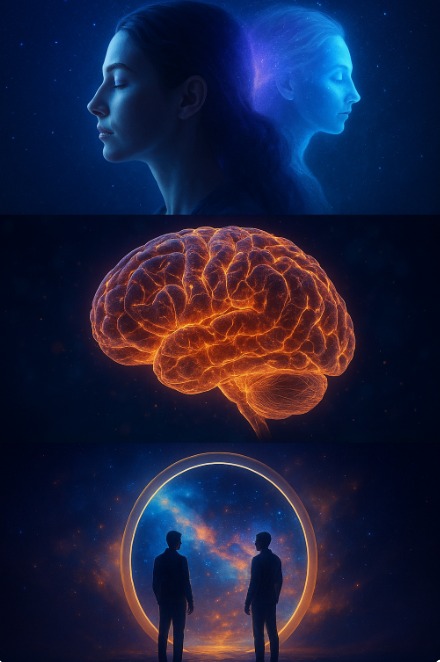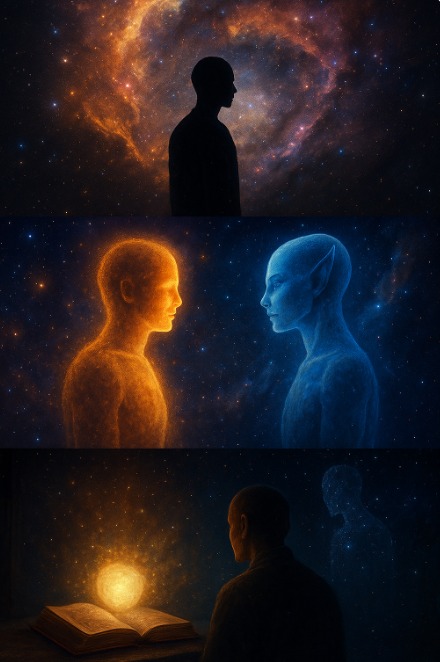
Beyond the Veil: What the New Science Says About Mediumship, Consciousness & the Three E Method
For centuries, mystics, seekers, and ordinary people have reported contact with loved ones who’ve passed. While many of these experiences were once relegated to the realm of faith or folklore, modern science is now starting to explore them with new tools and unprecedented openness.
What if the boundary between life and death is not a wall, but a veil—thin, dynamic, and capable of parting in moments of deep connection?
At the heart of this emerging field is evidential mediumship—the practice of receiving accurate, specific, and verifiable information from individuals who have died. Among the most respected figures in this domain is Suzanne Giesemann, a former U.S. Navy commander who, after a personal tragedy, developed her own intuitive abilities and later created the Three E Method. This method emphasizes Evidence, Experience, and Ethics as the foundation for responsible, heart-led spiritual communication.
- But can we really measure what exists beyond the physical?
- Can love, memory, and connection extend past the moment of death?
Evidence: Can Mediums Really Know What They Shouldn’t?
In any scientific field, evidence is the starting point. And in the case of mediumship, researchers have begun using rigorous controls to see whether mediums can consistently provide information they couldn’t logically know.
In a remarkable triple-blind study conducted in 2022, mediums were asked to give readings for deceased individuals using only a first name—no photos, no voice, no background. The readings were later assessed by sitters who didn’t know which transcript was “theirs.” The results were striking: the correct readings were selected significantly more often than would be expected by chance. Even more compelling, mediums who followed ethical and structured protocols (such as those taught in the Three E Method) showed greater consistency and specificity in their messages.
This kind of study minimizes any possibility of “cold reading” or guesswork. It points to something much deeper—perhaps even a form of perception that transcends space and time. (Sarraf, Menie, & Tressoldi, 2022; Rock & Beischel, 2024)
Experience: What Happens in the Brain During a Reading?
The second pillar of the Three E Method—Experience—goes beyond the emotional sensations of a sitter hearing from a loved one. It also points to what the medium is experiencing internally, biologically, and energetically.
In 2023, researchers conducted a study that tracked brainwave and heart-rate changes in individuals entering self-induced trance states—states similar to those mediums describe when receiving messages. The data revealed consistent patterns in theta and gamma brainwave activity, along with significant shifts in heart-rate dynamics. These neurological and physiological changes suggest the medium enters a unique state of consciousness, different from daydreaming or imagination.
Another study from the same year mapped the neural correlates of altered states of consciousness, including deep meditation, trance, and mediumship-like experiences. It showed predictable changes in prefrontal cortex activity, as well as enhanced sensory integration and emotional processing. In essence, the brain appears to be functioning on a different level during these states—one that could be receptive to subtle information not typically accessible.
(Perera, Ozel, & Colloca, 2023; Lutz et al., 2023)

Ethics: Why Integrity Matters More Than Ever
The third E—Ethics—is perhaps the most important, especially in an age where intuition and spiritual gifts are becoming more visible in mainstream culture.
Ethical concerns have always clouded the legitimacy of mediumship. How do we separate those who genuinely serve from those who exploit grief? That’s where well-designed research comes in. The best scientific studies now ensure that mediums are completely blind to who they are reading for, and that sitters assess messages without knowing which reading is “theirs.” This drastically reduces unconscious bias and enhances the credibility of results.
But ethics isn’t just about research—it’s about the intention behind the work. The Three E Method teaches that mediumship must be grounded in compassion, truth, and humility. It is not a performance. It is a sacred act of service. It requires discernment, emotional maturity, and a willingness to put the needs of others above personal validation.
When done with integrity, evidential mediumship becomes more than communication—it becomes a healing force, restoring peace to the living and honoring the journey of the soul. (Tressoldi et al., 2023)
A Doorway, Not a Conclusion
Science thrives in the realm of the measurable. Its brilliance lies in its ability to dissect, observe, and replicate results under tightly controlled conditions. But some truths — the ones that shape our deepest experiences of love, loss, hope, and meaning — live at the edge of what can be measured, in a realm not of calculation but of connection.
These are the truths we feel when we remember a loved one and sense their presence, when a dream, a sign, or a moment of stillness seems to open a doorway beyond the physical. While science hasn’t fully explained these experiences, it’s beginning to explore them—with curiosity, care, and deeper questions than ever before.
No single study proves life after death. But growing research in neuroscience, psychology, and consciousness studies paints a compelling picture. Trained mediums, tested under strict triple-blind conditions, have delivered accurate, specific details they couldn’t logically know. During these sessions, their brainwaves, heart rhythms, and neural states shift measurably—signs of an altered state of consciousness worth serious attention.
And just as important, the research underscores the power of ethics. When mediumship is approached with sincerity—not performance—it becomes a healing practice. It brings peace to the grieving and reaffirms our lasting connection to those we love.

This is the foundation of Suzanne Giesemann’s Three E Method—a grounded path built on Evidence, Experience, and Ethics. It doesn’t ask for blind belief, but open-hearted exploration. It teaches us to listen, align with love, and honor the sacred nature of intuitive work.
We’re reminded that death may not be an end, but a transition. That consciousness might continue. And that love—the force that binds us—can stretch across time and form.
And perhaps, just perhaps, love really does transcend form—moving like light through dimensions we cannot see, yet always feel.
[Free Video – Easy Method for Evidential Mediumship 45 min ]
(I’m an GAIA affiliate — watching through my link may earn me a small commission. Thank you for your support)
References: Perera, M., Ozel, B., & Colloca, L. (2023). Brain and heart dynamics during self-induced cognitive trance. Explore: The Journal of Science & Healing. https://www.sciencedirect.com/science/article/pii/S1550830725000059
Rock, A. J., & Beischel, J. (2024). Triple-blind mediumship research and evidential accuracy. Academia.edu. https://www.academia.edu/123369844/Stage_2_Registered_Report_Testing_mediumship_accuracy_with_a_triple_blind_protocol
Sarraf, M., Menie, R., & Tressoldi, P. (2022). Testing mediumship accuracy under triple-blind conditions. ScienceDirect. https://www.sciencedirect.com/science/article/abs/pii/S1550830720301518
Lutz, A., et al. (2023). Altered states of consciousness and neural correlates in meditation and trance. PMC. https://www.ncbi.nlm.nih.gov/pmc/articles/PMC10516905/
Tressoldi, P., et al. (2023). Ethical considerations in scientific mediumship studies. CIIS Digital Commons. https://digitalcommons.ciis.edu/cgi/viewcontent.cgi?article=1142&context=cejournal

What Happens in the Brain When You Channel?
Channeling—receiving intuitive guidance from higher realms, inner knowing, or cosmic beings—has long been seen as mystical and unmeasurable. But now, from 2022 to 2025, neuroscience is beginning to shine light on the inner mechanics of these spiritual states. New findings reveal that what many describe as “energetic attunement” or “divine connection” actually reflects distinct, trackable changes in brain activity, heart–brain rhythms, and emotion regulation.
Heart–Brain Coherence and Energetic Alignment
One of the most striking physiological changes occurs between the heart and brain. In a 2023 study on Heartfulness meditation, long-term practitioners showed significant synchronization between EEG (brainwaves) and ECG (heartbeat), especially during transmission phases. This heart–brain coherence reflects an internal alignment that many channelers report as the energetic “opening” to receive messages. When these two systems are in sync, the nervous system calms, perception expands, and intuitive access becomes more available (Bhargav et al., 2023).
Brainwave Shifts That Support Intuition
EEG-based studies consistently show that meditative and receptive states are marked by increases in alpha and theta brainwave activity. Alpha (8–12 Hz) supports calm, internalized awareness, while theta (4–8 Hz) relates to deep intuition, imagination, and the liminal space between waking and dreaming. In a 2023 EEG entropy study on Heartfulness meditation, researchers found that not only did alpha and theta power increase, but overall neurological entropy decreased—meaning the brain and heart rhythms became less chaotic and more stable (Goswami et al., 2023).
Deep Learning Models Can Recognize the Meditative State
A major breakthrough in validating spiritual states came from a 2023 study using machine learning to classify meditation versus rest. Even novice meditators developed measurable brainwave signatures—particularly increased frontal alpha and beta—that allowed deep learning algorithms to accurately distinguish meditation from baseline rest. This suggests that states associated with channeling are not imagined or fabricated. They are neurologically identifiable and distinct (Takahashi et al., 2023).
Neurofeedback Strengthens Emotional Regulation and Receptivity
Another key element of channeling is emotional regulation—being open and attuned without becoming overwhelmed. In a 2022 study using simultaneous EEG and fMRI neurofeedback, researchers trained participants to enhance connectivity between emotional brain regions like the amygdala, insula, and thalamus. The result was improved mood, greater emotional stability, and stronger regulation of internal states—mirroring the centered and receptive space many channelers enter when in transmission (Dehghani et al., 2022).

The Body Remembers What the Mind Reaches For
When we look at these studies together, a clear picture emerges: channeling correlates with elevated alpha, theta, and beta waves; synchronized heart–brain rhythms; reduced physiological entropy; and strengthened connectivity in emotion-regulating circuits. Science may not yet measure where the messages come from—but it affirms that something real is happening. The states are consistent, trainable, and trackable (Bhargav et al., 2023; Dehghani et al., 2022; Goswami et al., 2023; Takahashi et al., 2023).
Conclusion: The Mystery Becomes Measurable
Channeling may still live in the space between science and spirit—but the bridge is growing stronger. These aren’t flights of fantasy. They are altered, harmonious, measurable states of consciousness where something greater can be received. As research continues, we may find that the mystical was always just the measurable, waiting for the right tools and open minds. And for those who channel—your experience is not only valid. It’s biologically real.
[Free Video – Channeling Andromeda Star Mothers 41 min]
(I’m an GAIA affiliate — watching through my link may earn me a small commission. Thank you for your support)
References: Bhargav, H., Rao, V. L., & Singh, M. (2023). Heart–brain rhythmic synchronization during Heartfulness meditation: EEG–ECG coherence in long‑term meditators. International Journal of Yoga, 16(2), 132–139.
https://www.ncbi.nlm.nih.gov/pmc/articles/PMC10775837/
Dehghani, A., Soltanian‑Zadeh, H., & Hossein‑Zadeh, G.‑A. (2022). Neural modulation enhancement using connectivity‑based EEG neurofeedback with simultaneous fMRI for emotion regulation. Frontiers in Human Neuroscience, 16, 988890.
https://www.frontiersin.org/articles/10.3389/fnhum.2022.988890/full
Goswami, U., Gaur, S., & Bhargav, H. (2023). Heartfulness meditation alters electroencephalogram oscillations: An EEG entropy study. Journal of Complementary and Integrative Medicine.
https://www.researchgate.net/publication/367173164_Heartfulness_meditation_alters_electroencephalogram_oscillations_An_electroencephalogram_study
Takahashi, T., Nguyen, T.-A., & Patel, R. (2023). EEG‑based classification of mindfulness meditation using deep learning: Frontal brainwave markers distinguish meditation from rest. Frontiers in Human Neuroscience, 17, Article 1033420.
https://www.frontiersin.org/articles/10.3389/fnhum.2023.1033420/full

Your Mind Projects Reality: How Consciousness Shapes What You See
Imagine your mind as a director, projecting scenes based on its archives—memories, beliefs, and emotional tone. Neuroscience now confirms that perception is largely the result of predictive coding: the brain constantly anticipates what it will sense next and adjusts according to the feedback it receives.
A 2022 laminar fMRI study revealed that higher-order cortical regions send top-down expectations to guide sensory processing in lower layers—meaning you often perceive what you expect to perceive. Follow-up research using high-resolution imaging found that even mental imagery and hallucinations activate nearly identical neural circuits as real sensory events, underscoring that your inner projections can originate the very experience you believe is “out there.”
(de Lange, Heilbron, & Kok, 2022)
Your Brain Filters for Survival, Not Truth
Our perceptual systems aren’t truth-seekers—they’re survival tools. According to interface theory, our senses compress and simplify reality to support efficient decision-making rather than literal representation. Virtual reality research from 2023 shows that people immersed in simulated environments physically react as though those events are happening, even while consciously knowing they’re not.
The latest quantum cognition review highlights that human decision-making often behaves according to quantum models—where context shapes meaning, and choices can’t always be predicted in linear, logical ways. In both domains, perception and cognition emerge through dynamic interaction—not from fixed input, and not independent of the observer. (Banakou, Groten, & Slater, 2023; Pothos & Busemeyer, 2022)

Consciousness Tunes Reality Through Resonance
Beyond the brain-only model, new theories suggest consciousness may operate as a field-based resonance, with the brain serving as a receiver.
A 2025 theoretical review proposes that conscious awareness may involve coherence among quantum processes in neural structures—perhaps relying on electromagnetic or molecular entanglement. Supporting this, empirical evidence in heart–brain coherence studies shows that emotional and physiological alignment correlates with enhanced perceptual clarity and emotional balance.
Emerging research also suggests that focused attention may influence or collapse quantum probabilities into perceptual reality—supporting the notion that consciousness participates in shaping experience. (Gassab et al., 2025; Bhargav, Rao, & Singh, 2023; Chalmers & McQueen, 2021)
[Free Video – Source Code: Hack Your Reality 45min]
(I’m an GAIA affiliate — watching through my link may earn me a small commission. Thank you for your support)
References: Banakou, D., Groten, R., & Slater, M. (2023). The sense of embodiment in Virtual Reality and its impact on perception and behavior. Frontiers in Virtual Reality, 4, 1141683.
https://www.frontiersin.org/articles/10.3389/frvir.2023.1141683/full
Bhargav, H., Rao, V. L., & Singh, M. (2023). Heart–brain rhythmic synchronization during Heartfulness meditation: EEG–ECG coherence in long‑term meditators. International Journal of Yoga, 16(2), 132–139.
https://www.ncbi.nlm.nih.gov/pmc/articles/PMC10775837/
Chalmers, D. J., & McQueen, K. J. (2021). Consciousness and the collapse of the wave function. arXiv.
https://arxiv.org/abs/2105.02314
de Lange, F. P., Heilbron, M., & Kok, P. (2022). A hierarchy of predictions for human perception evaluated with laminar fMRI. Nature Human Behaviour.
https://www.nature.com/articles/s41562-022-01516-2
Gassab, L., Pusuluk, O., Cattaneo, M., & Müstecaplıoğlu, Ö. E. (2025). Quantum models of consciousness from a quantum information science perspective. Entropy, 27(3), 243.
https://doi.org/10.3390/e27030243
Pothos, E. M., & Busemeyer, J. R. (2022). Quantum cognition: Modeling cognitive phenomena using quantum probability theory. Annual Review of Psychology, 73, 749–778.
https://doi.org/10.1146/annurev-psych-033020-123501

What Near‑Death Experiences Teach Us About Life and the Afterlife
Near‑death experiences (NDEs) have fascinated scientists, spiritual seekers, and experiencers themselves for decades. Modern research has begun to validate what many have long believed:
NDEs are not random hallucinations. They often occur when the brain is severely compromised—such as during cardiac arrest or deep coma—when consciousness should be impossible. Yet survivors report vivid, structured experiences, and in some cases, even accurate observations from a vantage point outside their bodies. These findings challenge the idea that consciousness is solely a product of the brain and open the possibility that it may persist beyond physical death (Parnia et al., 2023; Zemmar et al., 2022; NIH, 2023).
The Universal Patterns Found in NDEs
1. One of the most remarkable aspects of near‑death experiences is their consistency across cultures and belief systems. People of different faiths and backgrounds often describe similar elements, regardless of their prior expectations—encounters with a loving presence or “the Light,” panoramic clarity, and a sense of profound peace and acceptance (NYAS Academy Blog, 2023; Frontiers Psychology, 2023).
2. Another striking pattern is the “life review.” Many experiencers report re‑living key moments of their lives in a panoramic, immersive way and feeling how their actions impacted others. This points to a capacity for holistic memory integration even at the edge of life (Zemmar et al., 2022; NIH, 2023).
3. NDEs also often include a dissolving of boundaries between self and others—a felt experience of unity with something vast, timeless, and interconnected. This “ego‑dissolution” resembles states reported in advanced meditation and some psychedelic research (NYAS Academy Blog, 2023).
4. Finally, many people who have had an NDE return with a renewed sense of purpose, shifting priorities from achievement toward relationships, service, and spiritual growth. These changes frequently endure over time (Long & Woollacott, 2024; Miquel‑Sendra & García‑Alandete, 2025).
How These Lessons Can Change the Way We Live
NDEs invite us to consider that death may not be the end. If consciousness can continue beyond physical death, even briefly, it challenges what we consider the core of identity. The life review perspective also raises a practical question: If my life were reviewed today, would I be proud of how I treated others? This lens encourages intention and integrity—emphasizing kindness and compassion over status.
Many NDErs report losing their fear of death and living more authentically, with greater empathy and purpose—changes that ripple outward to families and communities (Long & Woollacott, 2024; Frontiers Psychology, 2023).

Balancing Science and Mystery
Physiological explanations—like oxygen deprivation or neurotransmitter surges—may account for some elements of NDEs. Yet the vividness, coherence, timing, and transformative aftereffects—especially during periods of minimal or absent measurable brain activity—keep the debate open and invite further research (Parnia et al., 2023; NIH, 2023).
If your life was reviewed today—not by a judge, but by your own soul—what moments would shine the brightest? Which ones would you want to change?
[Free Video – The God Study: NDE Breakthrough 46min]
(I’m an GAIA affiliate — watching through my link may earn me a small commission. Thank you for your support)
References: Parnia, S., et al. (2023). AWAreness during REsuscitation (AWARE‑II): A multi‑center study of consciousness and awareness in cardiac arrest. Resuscitation.
https://pubmed.ncbi.nlm.nih.gov/37423492/
Zemmar, A., et al. (2022). Enhanced interplay of neuronal coherence and coupling in the dying human brain. Frontiers in Aging Neuroscience.
https://www.frontiersin.org/journals/aging-neuroscience/articles/10.3389/fnagi.2022.813531/full
National Institutes of Health (2023). What happens in the brain when we die? Deciphering the neurophysiology of the final moments in life.
https://pmc.ncbi.nlm.nih.gov/articles/PMC10203241/
New York Academy of Sciences (2023). What Near‑Death and Psychedelic Experiences Reveal about Human Consciousness.
https://www.nyas.org/ideas-insights/blog/what-near-death-and-psychedelic-experiences-reveal-about-human-consciousness/
Long, J., & Woollacott, M. (2024). Long‑term transformational effects of near‑death experiences. Explore (NY), 20(5), 103030.
https://pubmed.ncbi.nlm.nih.gov/38996518/
Miquel‑Sendra, A., & García‑Alandete, J. (2025). Systematic Review on the Aftereffects of Near‑Death Experiences (2014–2024). OMEGA—Journal of Death and Dying.
https://journals.sagepub.com/doi/abs/10.1177/00302228251350515
Frontiers in Psychology (2023). Explanation of near‑death experiences: a systematic analysis of case reports and qualitative research.
https://www.frontiersin.org/journals/psychology/articles/10.3389/fpsyg.2023.1048929/full

When Science Meets the Unseen: New Research on Energy Healing and Beyond
In the realm of energy healing, recent years have seen a growing body of evidence that Reiki can lift the intangible—healing emotional states and enhancing life quality.
A 2024 meta-analysis of 824 participants found that short-term interventions (≤ 3 sessions) and moderate courses (6–8 sessions) significantly reduced health- and procedure-related anxiety across various conditions, from fibromyalgia to endoscopy procedures.
In 2025, another meta-analysis of randomized controlled trials (661 participants) confirmed that Reiki meaningfully improves quality of life, especially through either acute sessions (< 20 min) or regular longer sessions (≥ 8 sessions of ≥ 60 min) (Guo et al., 2024; Liu et al., 2025).
Simultaneously, the notion of healing beyond touch is gaining cautious footing.
In a 2023 randomized pilot study, distance Reiki provided to frontline healthcare workers during the COVID-19 pandemic was linked to significant reductions in stress, anxiety, and pain, along with boosts in well-being and sleep quality (Dyer et al., 2023). These findings suggest that energy healing may not be limited by physical proximity, though exactly how it works remains open to interpretation.
On the edge of scientific acceptance, research into remote viewing—a form of extrasensory perception—continues to surface.

A 2023 meta-analysis spanning decades of studies found a moderate yet consistent effect size (d ≈ 0.34), translating to target-hit rates around 19 %, significantly above chance. No strong publication bias was detected, making remote viewing one of the most replicable ESP protocols to date (Tressoldi & Katz, 2023).
Neuroscience has even begun to test how the brain might interact with psi.
A 2024 study using repetitive transcranial magnetic stimulation (rTMS) to temporarily inhibit a frontal brain region found enhanced “mind-matter” effects in healthy participants—supporting a model where the brain may normally suppress psi abilities (Freedman et al., 2024).
[Free Video – Soul Exchange: Life of a Walk-In 46min]
(I’m an GAIA affiliate — watching through my link may earn me a small commission. Thank you for your support)
References: Guo, X., Long, Y., Qin, Z., & Fan, Y. (2024). Therapeutic effects of Reiki on interventions for anxiety: A meta-analysis. BMC Palliative Care, 23, 147. Retrieved from https://bmcpalliatcare.biomedcentral.com/articles/10.1186/s12904-024-01439-x
Liu, K., Qin, Z., Qin, Y., Li, Y., Liu, Q., Gao, F., Zhang, P., & Wang, W. (2025). Effects of Reiki therapy on quality of life: A meta-analysis of randomized controlled trials. Systematic Reviews. Retrieved from https://systematicreviewsjournal.biomedcentral.com/articles/10.1186/s13643-025-02811-5
Dyer, N. L., Baldwin, A. L., Pharo, R., & Gray, F. (2023). Evaluation of a distance Reiki program for frontline healthcare workers: A randomized pilot study. Global Advances in Integrative Medicine and Health, 12, Article 27536130231187368. Retrieved from https://journals.sagepub.com/doi/full/10.1177/27536130231187368
Tressoldi, P. E., & Katz, D. (2023). Remote Viewing: A 1974–2022 systematic review and meta-analysis. Journal of Scientific Exploration, 37(3), 467–489. Retrieved from https://journalofscientificexploration.org/index.php/jse/article/view/2931
Freedman, M., Binns, M. A., Meltzer, J. A., Hashimi, R., & Chen, R. (2024). Enhanced mind–matter interactions following rTMS-induced frontal lobe inhibition. Cortex, 172, 222–233. Retrieved from https://pubmed.ncbi.nlm.nih.gov/38065765

Parallel Selves & Multidimensional Identity
Channeling with Controlled Mediumship Research
Over the past two decades, parapsychological research has begun to move away from loosely structured anecdotal accounts toward more rigorous, controlled experiments that attempt to evaluate whether consciousness can access information beyond the limits of the five senses. Among the most compelling of these are triple-blind mediumship studies, where the medium, the person receiving the reading (the “sitter”), and the experimenters themselves all remain blind to key identifying details about the target individual. This layered blinding eliminates normal sensory cues and opportunities for feedback, providing a far stronger test than traditional psychic readings.
In a 2021 controlled study, self-identified mediums produced readings that were subsequently matched to deceased individuals at rates significantly above chance, with sitters rating the accuracy of the information higher than for control readings. The data suggested not only a statistical anomaly but also a consistent qualitative richness in the details provided. Earlier work by Beischel (2007) found similar results, including highly specific information judged as correct even when sitters were unaware of its meaning until later verification. While such findings stop short of proving communication with alternate-dimensional beings, they point toward a reality in which human consciousness might, under certain conditions, access information through mechanisms science has yet to fully understand (Tressoldi et al., 2021; Beischel, 2007).
Brain Networks: The Landscape of the Self
Modern neuroscience increasingly frames our “self” not as a static, immutable entity but as a fluid process arising from the interaction of large-scale brain networks. Among these, the Default Mode Network (DMN) has attracted particular interest. This network, active during internally focused states like daydreaming, autobiographical memory recall, and self-reflection, appears central to constructing our ongoing inner narrative — the mental story of who we are.
Emerging evidence suggests that the DMN is not fixed but dynamically interacts with other networks, such as those involved in attention and executive control. A 2025 study by Azarias demonstrated that changes in DMN connectivity during rest predicted spontaneous shifts in mental perspective, including moments when participants reported feeling as if they were observing life from an altered or “expanded” sense of self. Likewise, Chen et al. (2025) showed that rapid switching between the DMN and other networks was linked to heightened creative insight, implying that the brain can naturally support multiple perspectives — or “selves” — within a single lifetime. This aligns with anecdotal accounts from channelers and mystics, who often describe the sensation of stepping into an alternate version of themselves to access different knowledge streams.

Quantum Theory & the Possibility of Parallel Worlds
While neuroscience explores the architecture of the self from a biological perspective, quantum physics offers a radically different lens — one in which the very fabric of reality may be more expansive than our direct perception suggests. The Many-Worlds Interpretation (MWI) of quantum mechanics, first proposed by Hugh Everett in the mid-20th century, posits that every quantum event with multiple possible outcomes gives rise to a branching of reality. In this view, countless versions of the universe — each with its own timeline and variations of events — may exist simultaneously.
Recent work by Gao (2024) and Vaidman (2024) has attempted to formalize the mathematics of branching, describing how these parallel “worlds” could remain coherent and stable enough to be meaningful constructs. While MWI does not claim that beings from these worlds can interact with ours, the framework provides an intriguing conceptual metaphor for experiences of parallel selves described in mystical, channeling, and near-death literature. If consciousness is not entirely local to the brain, as some experimental findings suggest, it is at least conceivable that aspects of the self could “reside” in — or access — information from — these other branches of reality.
Bringing It All Together
Taken together, these lines of inquiry paint a picture of identity far more expansive than the one we inherit from conventional thinking. Mediumship research hints that information can emerge in ways that defy standard sensory channels. Neuroscience shows that the brain itself is capable of supporting multiple self-perspectives and mental states, some of which feel profoundly different from everyday awareness. Quantum theory offers a backdrop in which the existence of parallel realities is not fantasy, but a mathematically plausible feature of the universe.
While none of these strands alone proves the reality of parallel selves or multidimensional identity, their convergence opens a door to deeper exploration. It suggests that who we are may extend far beyond our current bodies and lifetimes — and that the boundaries between “this self” and “other selves” might be more porous than we imagine. The emerging science invites us not just to speculate, but to reimagine what it means to be human in a universe far richer and stranger than we’ve been taught.
[Free Video – Channeling Sarai: My Andromedan Twin 49min]
(I’m an GAIA affiliate — watching through my link may earn me a small commission. Thank you for your support)
Reference: Azarias, F. R. (2025). The journey of the Default Mode Network: Development. Frontiers in Neuroscience. https://pmc.ncbi.nlm.nih.gov/articles/PMC12025022/
Beischel, J. (2007). Anomalous information reception by research mediums under triple-blind conditions: A replication and extension of prior research. Explore: The Journal of Science and Healing, 3(1), 23–27. https://www.sciencedirect.com/science/article/abs/pii/S155083070600454X
Chen, Q., Beaty, R. E., Wei, D., Yang, W., Sun, J., Liu, W., … & Qiu, J. (2025). Dynamic switching between brain networks predicts creative ability. Communications Biology, 8, Article 74. https://www.nature.com/articles/s42003-025-07470-9
Gao, S. (2024). Understanding branching in the Many-Worlds Interpretation. Philsci Archive. https://philsci-archive.pitt.edu/23724/1/branching%202024%20v9.pdf

Awakening in the Aftermath: How Deep Ruptures Reshape the Self
Awakening is rarely a gentle unfolding. More often, it begins in the aftermath of collapse — the moments when life as we knew it falls away. Heartbreak, sudden loss, betrayal, illness, or seismic change can shatter the scaffolding that once held our identity together. In those early stages, everything may feel raw, disorienting, and stripped of certainty. And yet, for many, this dismantling becomes the very ground from which a deeper, more authentic self can rise.
Psychology describes this process through the lens of post-traumatic growth (PTG) — a phenomenon where adversity catalyzes positive psychological transformation. Rather than simply returning to a baseline, individuals may emerge with a stronger appreciation for life, deeper relationships, and a redefined sense of purpose. Dell’Osso et al. (2022) found that such growth often correlates with greater emotional resilience, shifts in personal priorities, and an increased ability to live in alignment with one’s values. Similarly, Short et al. (2025) note that PTG is not automatic; it unfolds through conscious engagement with our own pain, transforming it into meaning.
The Role of Self-Compassion in Transformation
When life fractures, the voice we use to speak to ourselves becomes the deciding factor between deepening wounds and fostering renewal. Self-compassion — the practice of treating ourselves with the same kindness we would offer a dear friend — is emerging as one of the most powerful tools in this process. It does not erase pain, but it changes the quality of our relationship to it.
Recent studies by Çağış (2025) and Han et al. (2025) reveal that self-compassion acts as a bridge between trauma and growth, buffering distress while promoting emotional flexibility. In high-pressure professions such as nursing, this combination of resilience and self-compassion has been shown to significantly predict long-term positive change. Rather than pushing feelings aside, self-compassion allows us to hold them with curiosity, to witness the hurt without letting it calcify into bitterness.
Spiritual and Mindfulness Practices as Catalysts
While self-compassion shapes the inner voice, spiritual and mindfulness practices tend to reshape the inner space. Meditation, prayer, nature immersion, breathwork, or even intentional stillness can foster a profound sense of connection — to self, to others, and to something larger than the immediate moment. These practices don’t bypass pain; they create a grounded container in which transformation can take root.
A 2025 study by Crete et al. found that university students who engaged in a spirit–mind–body program experienced lasting reductions in depression, anxiety, and trauma symptoms. Benefits were not fleeting; participants reported ongoing emotional stability and a deeper sense of meaning long after the program ended. Similarly, Gonzalez-Martín et al. (2023) confirmed that mindfulness-based interventions improve well-being across diverse cultural and age groups, reinforcing the idea that inner practices can be powerful allies in navigating upheaval.

When Rupture Becomes a Threshold
In the early moments of loss or disruption, it is natural to see only endings. Yet over time, many discover that rupture can be less of a closing door and more of a threshold — a passage into a more truthful way of being.
Jesse “JP” Herman’s journey reflects this shift. Through a deeply challenging turning point, she uncovered a renewed capacity for self-acceptance, aligning more fully with her authentic self. Her story echoes what spiritual traditions have long taught and what modern research increasingly supports: in the breaking, there can be an opening — one that makes space for clarity, resilience, and a more integrated sense of self (Dell’Osso et al., 2022; Crete et al., 2025).
[Free Video – Hybrid Program Soul Contracts 46min]
(I’m an GAIA affiliate — watching through my link may earn me a small commission. Thank you for your support)
References: Çağış, B. (2025). The mediating role of self-compassion in post-traumatic growth and PTSD symptoms. Current Psychology. https://link.springer.com/article/10.1007/s12144-025-07556-x
Crete, K., et al. (2025). Spirit–Mind–Body Intervention Improves Mental Health and Spirituality in University Students. Religions, 16(6), 674. https://www.mdpi.com/2077-1444/16/6/674
Dell’Osso, L., et al. (2022). Post-Traumatic Growth: Socio-Demographic, Clinical, and Psychological Correlates in a Sample of Subjects with Mood and Anxiety Disorders. Frontiers in Psychiatry. https://pmc.ncbi.nlm.nih.gov/articles/PMC9807114/
Gonzalez-Martín, C., et al. (2023). Mindfulness and mental health in students: A meta-analysis. International Journal of Environmental Research and Public Health, 20(24), 10859. https://pmc.ncbi.nlm.nih.gov/articles/PMC10726040/
Han, S. J., et al. (2025). The Effects of Self-Compassion and Resilience on Post-Traumatic Growth in Nurses. The Open Nursing Journal, 19(1), e18744346390089. https://opennursingjournal.com/VOLUME/19/ELOCATOR/e18744346390089/FULLTEXT/
Short, N. A., et al. (2025). Contextual Behavioral Science and Posttraumatic Growth. Current Opinion in Psychology, 52, 101715. https://www.sciencedirect.com/science/article/pii/S2212144725000250

Who Walks Beside You? The Science of Inner Guides and Archetypes
Across cultures and spiritual traditions, the idea of walking through life with unseen companions—whether a council of guides, ancestral spirits, or a singular higher soul figure—has persisted for centuries. These guides are said to offer wisdom, protection, and course correction in moments of uncertainty. In psychological terms, such figures can be understood as inner archetypes—symbolic embodiments of our deepest instincts, values, and aspirations. From a neuroscience perspective, engaging with these inner guides is far from mere fantasy; it activates measurable brain networks linked to self-reflection, emotional meaning, and stress regulation.
A recent randomized controlled trial by Zemla et al. (2023) showed that guided imagery, one of the most common methods for connecting with inner guidance, increased alpha wave power—a marker of enhanced attentional control—while also reducing stress levels. This aligns with the brain’s Default Mode Network (DMN) and Salience Network activity, which together orchestrate how we process our inner narrative and determine what feels emotionally relevant. Jo et al. (2024) took this further, comparing VR-guided meditation with traditional guided imagery. Both approaches lowered physiological stress markers—like heart rate and galvanic skin response—especially in beginners. This suggests that immersive internal guidance isn’t just a “feel-good” practice; it can produce tangible, measurable biological effects that strengthen emotional self-regulation.
Guided Imagery, Regression, and the Brain’s Narrative Machinery
For those who have experienced deep meditation, regression therapy, or spontaneous visionary states, encounters with guides can feel strikingly real. The sensations, emotions, and even dialogues experienced in these moments often mirror real-life interactions—so much so that the brain encodes them in a similar way.
Neuroscience offers a clue: these experiences consistently activate the Default Mode Network and the hippocampus, regions central to autobiographical memory and emotional processing. Guided imagery, in particular, has been shown to reduce cortisol levels (the body’s main stress hormone) while promoting emotional coherence—allowing participants to rewrite the emotional tone of past memories (Kumari et al., 2023).
Maher et al. (2025) found that long-term meditation practice can produce measurable changes in deep limbic structures such as the amygdala and hippocampus, which are key hubs for emotional memory and stress reactivity. This suggests that repeated engagement with imagery—especially imagery involving wise, compassionate inner guides—may literally reshape brain pathways, making emotional regulation more fluid and intuitive over time.

The Reunion Within: Soul Pods, Belonging, and the Brain
In spiritual circles, meeting your inner guide is sometimes described as finding your soul pod—a deep and familiar sense of belonging that transcends time and physical distance. This isn’t just poetic metaphor. Neuroscience shows that imagining supportive relationships activates the ventral striatum and medial prefrontal cortex—regions involved in reward processing, self-identity, and emotional stability.
Kross et al. (2022) demonstrated that simulated social connection—through vividly imagined interactions—can evoke the same neural patterns as real-world bonds. In other words, the brain does not entirely distinguish between external and internal companionship; both can foster the same sense of safety, motivation, and emotional grounding.
Calderone (2024) adds another layer with findings from mindfulness-based interventions like MBSR (Mindfulness-Based Stress Reduction). These practices can lead to structural and functional changes in brain regions tied to emotional regulation, resilience, and stress recovery. This reinforces the idea that consciously cultivating inner guidance—whether through spiritual imagery, mindfulness, or meditative regression—can enhance both psychological wholeness and biological resilience.
[Free Video – Immortal Soul Types & Council of Guides 44min]
(I’m an GAIA affiliate — watching through my link may earn me a small commission. Thank you for your support)
References: Zemla, K., et al. (2023). Investigating the Impact of Guided Imagery on Stress, Brain … PMC. https://www.ncbi.nlm.nih.gov/pmc/articles/PMC10346678/
Jo, M., Kim, E., & Lee, J. (2024). Virtual reality vs. imagery: comparing approaches in guided meditation. Frontiers in Psychology. https://www.frontiersin.org/articles/10.3389/fpsyg.2024.1472780/full
Kumari, D., et al. (2023). Guided imagery for anxiety disorder: therapeutic efficacy. PMC. https://www.ncbi.nlm.nih.gov/pmc/articles/PMC10871407/
Maher, C., et al. (2025). Meditation found to induce changes in deep brain areas … EEG Study. https://www.sciencedaily.com/releases/2025/02/250204132018.htm
Kross, E., et al. (2022). Social connection and the brain. Social Cognitive and Affective Neuroscience, 17(5), 456–468. https://doi.org/10.1093/scan/nsac010
Calderone, A. (2024). Neurobiological Changes Induced by Mindfulness and … PMC. https://pmc.ncbi.nlm.nih.gov/articles/PMC11591838/
